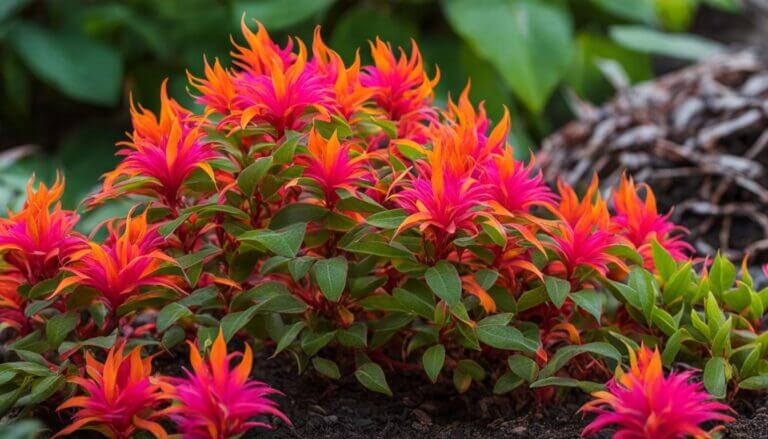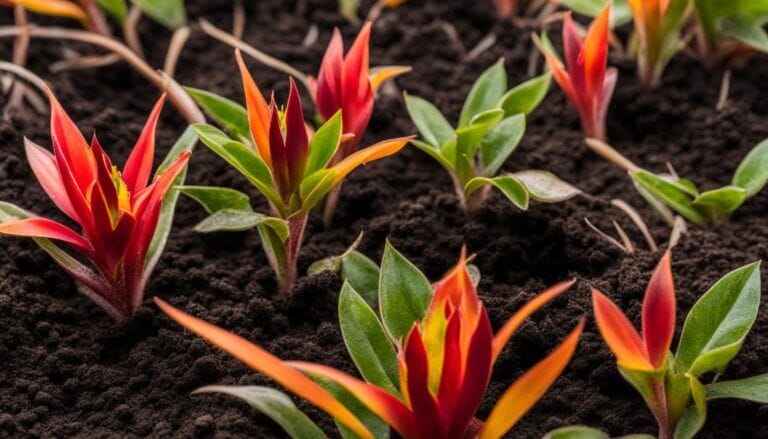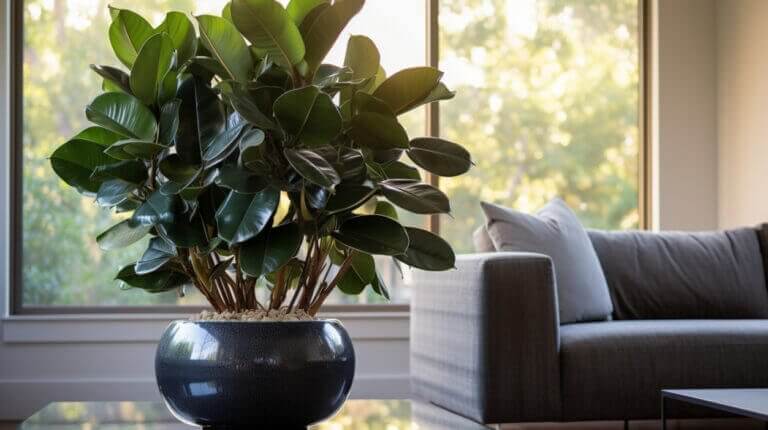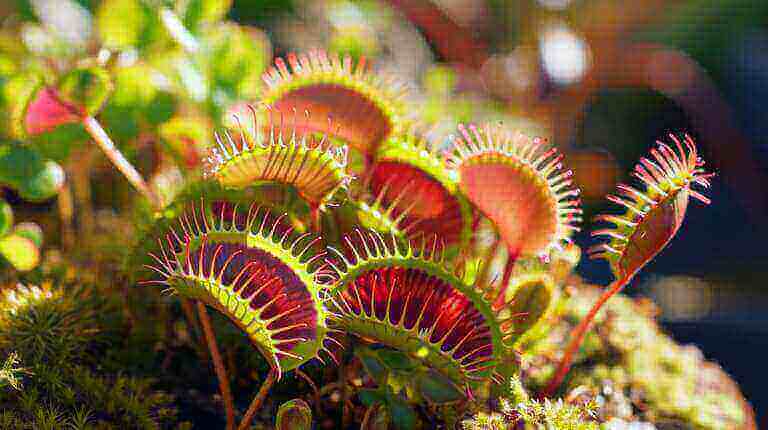Are you longing for a touch of nature in your home? Look no further than the arrowhead plant.
Imagine the satisfaction of growing your own lush and vibrant arrowhead plant from a bulb. In just a few simple steps, you can turn your space into a botanical oasis.
With our step-by-step instructions, you’ll learn how to choose the right bulb, prepare the planting medium, and provide the ideal growing conditions.
Join the community of arrowhead plant enthusiasts and experience the joy of nurturing your very own plant.
Key Takeaways
- Select a healthy and disease-free bulb and store it properly.
- Choose a pot with good drainage and use well-draining potting soil.
- Plant the bulb at the right depth and orientation.
- Provide the ideal growing conditions including light, temperature, and humidity, and regularly care for and maintain the plant.
Choosing the Right Bulb
To successfully grow an arrowhead plant from a bulb, you need to start by selecting the right bulb for your plant. The first step is to choose a bulb that’s healthy and disease-free. Look for bulbs that are firm to the touch and free from any signs of rot or mold.
It’s also important to consider the size of the bulb. A larger bulb will typically produce a larger and more robust plant. Once you have selected the right bulb, it’s crucial to store it properly before planting. Bulbs should be stored in a cool, dry place away from direct sunlight. Avoid storing them in a humid environment as this can promote mold growth.
Preparing the Planting Medium
To prepare the planting medium for growing an arrowhead plant from a bulb, gather a sufficient amount of well-draining potting soil. Ensure that the soil is loose and crumbly, allowing for proper root growth and water drainage. Here are some tips to help you create the perfect planting medium:
- Choose a pot that’s slightly larger than the bulb, allowing room for growth. Opt for a pot with drainage holes to prevent waterlogging.
- Select a potting soil that’s rich in organic matter and has good drainage. Avoid heavy clay soils that can retain too much moisture.
- Add some perlite or sand to the potting soil to improve drainage and loosen the texture.
- Mix in some well-aged compost or organic fertilizer to provide essential nutrients for the plant’s growth.
Remember to select the appropriate watering schedule for your arrowhead plant. These plants prefer slightly moist soil, so water them when the top inch of soil feels dry to the touch. Avoid overwatering, as it can lead to root rot and other diseases.
Planting the Bulb
Once you have prepared the planting medium, it’s time to plant the bulb of your arrowhead plant.
The planting depth is an important factor to consider. Dig a hole in the center of the medium, making sure it’s deep enough to accommodate the bulb. A general rule of thumb is to plant the bulb at a depth that’s two to three times its diameter.
Place the bulb in the hole with the pointed end facing up. Gently cover the bulb with the planting medium, ensuring that it’s completely covered. Press the medium down lightly to secure the bulb in place.
After planting, water the bulb thoroughly, making sure the soil is evenly moist. However, avoid over-watering as excessive moisture can lead to rot. Monitor the watering frequency to maintain a slightly moist but not waterlogged environment for optimal growth.
Providing the Ideal Growing Conditions
After planting the bulb, you can provide the ideal growing conditions for your arrowhead plant. To ensure healthy growth and vibrant foliage, follow these indoor gardening tips for optimal houseplant care:
- Lighting: Place your arrowhead plant in a bright spot, but avoid direct sunlight as it can scorch the leaves. Indirect, filtered light is best for this shade-loving plant.
- Temperature: Maintain a consistent temperature between 60-75°F (15-24°C). Avoid exposing the plant to extreme temperature fluctuations, drafts, or cold drafts from windows or doors.
- Humidity: Arrowhead plants thrive in high humidity levels. Increase humidity by placing the pot on a tray filled with water and pebbles. Regularly misting the leaves also helps create a humid environment.
- Watering: Keep the soil consistently moist, but not waterlogged. Water when the top inch of soil feels dry to the touch. Ensure proper drainage to prevent root rot.
Caring for and Maintaining Your Arrowhead Plant
To care for and maintain your arrowhead plant, you should regularly monitor its watering needs, provide adequate humidity, and ensure it receives proper light and temperature conditions.
The watering schedule for your arrowhead plant is crucial to its health. It’s recommended to water the plant when the top inch of soil feels dry. Overwatering can lead to root rot, so be cautious not to let the plant sit in waterlogged soil.
In terms of humidity, the arrowhead plant thrives in a humid environment. You can increase humidity by misting the leaves with water or placing a tray of water near the plant.
Additionally, the arrowhead plant requires bright, indirect light. It should be placed near a window but away from direct sunlight.
As for temperature, the plant prefers temperatures around 60-75°F (15-24°C).
Pruning techniques can help maintain the plant’s shape and promote new growth. Regularly trim any yellow or brown leaves to prevent disease and maintain the plant’s overall appearance.
Frequently Asked Questions
How Long Does It Take for an Arrowhead Plant Bulb to Sprout?
It typically takes about 4 to 6 weeks for an arrowhead plant bulb to sprout. The growth timeline can be influenced by various factors such as temperature, humidity, and soil moisture.
Proper care and maintenance are crucial to ensure successful sprouting. To promote bulb sprouting, provide a warm and humid environment, keep the soil consistently moist, and avoid exposing the plant to extreme temperatures.
With the right conditions, you’ll soon see your arrowhead plant bulb sprouting and thriving.
Can I Plant Multiple Arrowhead Plant Bulbs in the Same Pot?
Sure, you can definitely plant multiple arrowhead plant bulbs in the same pot. However, it’s crucial to consider the pot size to ensure adequate space for each bulb’s growth.
Choosing a pot that provides sufficient room for the roots to spread out is essential for a thriving arrowhead plant. Remember, each bulb needs its own space to flourish and avoid overcrowding.
Can I Grow an Arrowhead Plant From a Cutting Instead of a Bulb?
Yes, you can definitely grow an arrowhead plant from a cutting instead of a bulb. This method of propagating arrowhead plants is a great alternative to growing from bulbs.
To start, select a healthy stem cutting with a few nodes. Remove the lower leaves and place the cutting in water or a well-draining soil mix.
Keep the cutting in a warm, humid environment and watch as roots develop. Once the roots are established, you can transplant the cutting into a pot and continue to care for it as you’d with a bulb-grown plant.
How Often Should I Water My Arrowhead Plant Once It Is Established?
Once your arrowhead plant is established, it’s crucial to water it appropriately to ensure its health. The frequency of watering will depend on various factors, such as the size of the pot, the temperature, and the humidity levels in your environment.
In general, you should aim to keep the soil consistently moist but not overly saturated. Regularly check the soil’s moisture level by sticking your finger an inch deep into the soil. If it feels dry, it’s time to water.
Remember to maintain a balanced watering schedule to avoid root rot.
Do Arrowhead Plants Require Any Special Pruning or Trimming?
To maintain a healthy arrowhead plant, regular pruning is essential. By employing proper arrowhead plant pruning techniques, you can enhance its overall appearance and promote vigorous growth. Trimming helps remove any dead or damaged leaves, allowing for new growth and preventing the spread of diseases.
Additionally, it encourages branching and creates a fuller, more lush plant. Remember, consistent and careful trimming brings numerous benefits to your arrowhead plant’s well-being.







